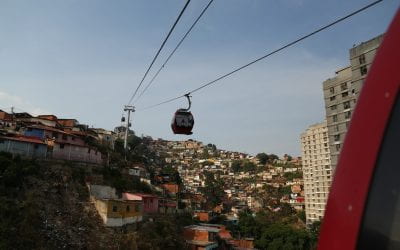Editor’s Letter
Water Facets
When I’m feeling a bit blue on dark winter days, words about water flow into my head: John Masefield’s “I must go down to the sea again” or the 23rd Psalm’s quiet rhythms, “He leadeth me beside still waters.” A walk down Riverside Drive or a stroll along the beach in Cartagena or Coney Island both calms and energizes me.
The fountains of Antigua and Oaxaca remind me of time and timelessness. Although colonial in origin, they hark to life’s basic necessity: water. I’ve long thought this deep spiritual feeling about water was something particular to me. So it was quite a surprise when I discovered my friend Marianne Kinzer (whose photoessay is on p. 36) felt the same way:
Now, I am thinking about Oaxaca again and its water. We went to a village in the mountains, where the mythical birthplace of the Mixtec people is said to be located: Apoala. It is a village in the mountains around Oacaxa. There, a stream originates in a cave, and the first ancestors of the Mixtec people were born…. I took a few photos of the stream emerging from the cave. A brook emerges from the cave and later falls down to lower lying valleys. Above one of the two waterfalls here in Apoala—mythology tells us—the first human was born from a tree. This event is supposedly recorded in the Nutall Codex. I reflected on the importance of water especially for an agricultural society. The tree is very much related to humanity as well. I regard stories like that as ancient knowledge of the importance of water of humankind.
Like Marianne Kinzer, I’d spent months reflecting on the importance of water as I prepared this issue. Dams, hydroelectric power, water filters, territorial disputes over water, climate change, privatization, irrigation: how was I ever going to cover it all in one single issue of ReVista?
John Briscoe, who directs the Harvard’s Water Security Initiative and has done extensive work on water management in Brazil, provided invaluable help as I shaped the magazine. He pointed me toward the future and the indispensable role of water in development.
It was not until I began reading Steven Mithen’s brilliantly written Thirst: Water and Power in the Ancient World (Harvard University Press, 2012) that I could connect the powerful surge of water in the spiritual realm with the complicated world of water management. Mithen points out that the lowland centers of the Maya population—the predecessors of those bubbly fountains— were built in a landscape with little permanent water supply. First relying on natural accumula- tion of water in depressions, the Mayan people eventually used centralized planning to build complicated hydraulic systems over wide swaths of land, Mithen tells us. Water management included aqueducts, dams, channels, drains and reservoirs. Droughts and floods were a reality of every day life, and both ritual and engineering were thought necessary to control them. Likewise, in Peru’s Machu Picchu, an icon of lost civilizations, the Inca gained sophisticated expertise
in hydraulic engineering. “[The Inca’s] military, political and cultural achievements ultimately derived from the management of water,” Mithen observes.
My former visits to the monumental Mayan ruins or Machu Picchu had evoked awe and spiritual connections to a past that is only vaguely mine. Now, for me, those ruins connect ahead to a world confronted with floods, storms and climate change. This fall’s Hurricane Sandy, with its flooding, brought a new aspect of water management to a city as developed as New York. It battered and damaged Santiago de Cuba—usually highly prepared for hurricanes. And only a few weeks later, torrential rains ravaged Panamá, the gateway between North and South America.
Perhaps science and spirituality are not so far apart, I thought. Water is power and water is life, and we cannot control it all.
Winter 2015, Volume XIV, Number 2
Related Articles
Editor’s Letter – Animals
Editor's LetterANIMALS! From the rainforests of Brazil to the crowded streets of Mexico City, animals are integral to life in Latin America and the Caribbean. During the height of the Covid-19 pandemic lockdowns, people throughout the region turned to pets for...
Editor’s Letter – Museums
Editor's LetterMuseums. They are the destination of school field trips, a place to explore your own culture and a great place to run around and explore. They are exciting or boring, a collection of objects or a powerful glimpse into other worlds. Until recently—with...
Editor’s Letter: Transportation
Bridges. Highways. Tunnels. Buses. Trains. Subways. Transmilenio. Transcable. When I first started working on this issue of ReVista on Transportation (Volume XXI, No. I), I imagined transportation as infrastructure.


